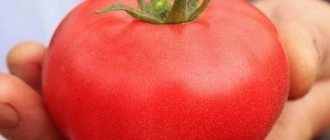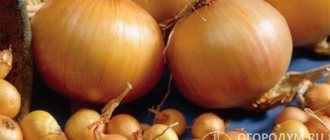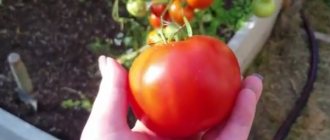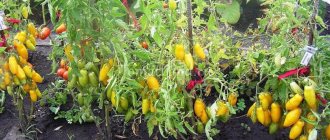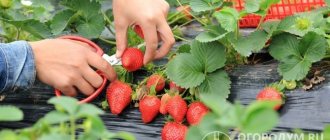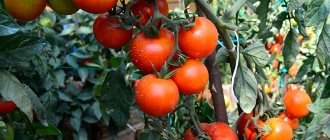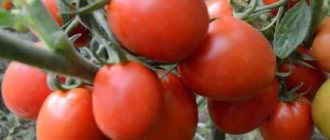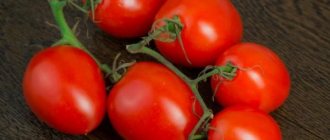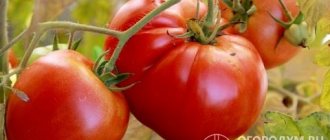Description and characteristics of the variety
- Early ripening variety. In good weather, 85-90 days after the seeds sprout, you can enjoy the first fruits. In unfavorable weather, fruits appear on day 100-110. In Eastern Siberia, you will be able to enjoy the first fruits after 110-120 days.
- It can be grown in open ground in the central regions of the country, in a greenhouse - in northern regions with short summers.
- Determinate type of bush. The stem is limited in growth after the formation of several racemes. The height reaches no more than 50-60 cm.
- Not standard, so stepsoning is necessary.
- The bushes are compact with a powerful stem.
- Medium branching, strong foliage. The leaves are small with slightly corrugated leaf blades.
- The first brush is formed after 5-6 sheets, then every 1-2 sheets. There are no more than 2-3 brushes on each stem.
- Productivity is average. One plant produces 2-3 kg of vegetables. 6-8 kg of vegetables are harvested per square meter. Productivity greatly depends on the growing region, weather conditions and agricultural technology. In a greenhouse, one plant produces about 4-5 kg of tomatoes.
- Resistant to macrosporiosis, bacterial spot, blossom end rot. Cold rainy summer Can be affected by late blight and septoria. Thanks to the early ripening period, gardeners have time to harvest ripe tomatoes before these diseases begin to spread en masse.
- May be affected by tobacco mosaic.
Important! Seedlings that were planted early in open ground may be attacked by the Colorado potato beetle.
The most common is the classic Liana tomato variety. It produces red tomatoes. However, there is also pink Liana. It has similar characteristics, but its fruits are more sugary. The fruits weigh about 100 g and have a pink-raspberry peel with a pearlescent tint. Pink hybrid bushes grow up to 70 cm in height.
Pest and disease control
The main measures to prevent the development of diseases are the following preventive actions:
- keeping the site, greenhouse, and work equipment clean;
- timely removal of weeds, damaged leaves, plants with signs of disease;
- avoid excess moisture;
- plant plants next to tomatoes that repel disease carriers (aphids, ticks);
- treatment of seedlings with bromine solution and copper-containing preparations.
Fruit characteristics
- The shape is round, smooth, even.
- Color red or pink.
- Weight 50-80 g.
- Inside there are 2-4 seed chambers with a small number of medium-sized seeds.
- The taste is excellent, tomato.
- The pulp is juicy, dense, sweetish with a slight sourness.
- The fruits have a beautiful presentation.
- The concentration of dry substances is about 6%.
- The skin is dense.
- Do not crack.
- Resistance to transportation.
- Can persist for a long time.
Appearance
In appearance, the Liang tomato fruits are similar to many other red-fruited varieties, since they have a classic round shape and color. Even a specialist can easily confuse it with at least several dozen similar varieties; differences can only be observed in the details.
Liana tomato fruits are regular in shape, approximately the same size, bright red
Pink Lyana looks similar, but the fruits have a completely different, very elegant color.
The fruits of pink Lyana are just as smooth and regular in shape, but their color is completely different
Actually, the bushes, covered with numerous tomatoes, resemble the bushes of some other early determinate varieties, for example, the Beta tomato.
Features of cultivation
It is worth knowing the rules of agricultural technology for the Lyana variety.
Planting seedlings
In the southern regions, this variety is sown directly into the ground. In other regions, it is recommended to grow using seedlings.
When and how to plant seedlings
Seeds for seedlings for cultivation in open ground are sown in the last ten days of March or before April 7, for a greenhouse - from February 20 to March 7.
Before sowing, the seeds are kept in a weak solution of potassium permanganate for about 30 minutes. Then they are soaked for several hours in the growth stimulator Epin or Zircon. If the seeds were purchased at a garden store, they have already been processed, so they do not need to undergo such procedures.
To plant seeds, it is best to buy a ready-made soil mixture for growing seedlings. The soil is poured into prepared containers, moistened well, and the seeds are buried 1 cm into the soil. To create a greenhouse effect, the containers are covered with transparent material and left in a warm room with an air temperature of 25 degrees.
After the shoots emerge, the film is removed and the temperature in the room is lowered by 7-8 degrees so that the seedlings do not stretch upward. After the appearance of 1-2 leaves, a pick is carried out.
During the procedure, the tip of the root is pinched. This is necessary to stimulate the growth of lateral roots.
Transplanting seedlings into the ground
They are transferred to the ground after 55-60 days. By this point, the soil should warm up, and the air temperature should remain within 15 degrees. It all depends on the growing region:
- to the greenhouse - April-May;
- in open ground - May-June.
By this time, the seedlings can already bloom. They can be sprayed with boron to improve fruit set. To improve the plant's stress resistance to transplantation, growth stimulants Epin or Zircon are used.
Bushes are planted according to the scheme 60 x 40 cm, 60 x 60 cm. The main thing is that no more than 2-3 plants are planted per square meter. Plantings should not be thickened in order to be well ventilated.
It is recommended to plant tomatoes in well-lit and ventilated places where the soil is loose and fertile. According to crop rotation, it is better to plant tomatoes in places where legumes or grains, cabbage or perennial herbs were previously grown.
Tomatoes should not be planted after eggplants, peppers and potatoes.
Subsequent care for tomatoes
Plants need to be watered regularly. The soil should be moistened to the depth of the root system. Each gardener selects the frequency of watering independently, depending on the soil and weather conditions. However, they do this no more than twice a week.
Liang's tomatoes on video
A huge number of varieties of tomatoes with descriptions, photos, reviews from gardeners in our Tomato Catalog. Enjoy watching.
If you grew Liang tomatoes, please write if you liked them? Many call this variety the best of all early low-growing tomatoes - do you think the same? How do you rate the disease resistance of this variety? Briefly describe the advantages and disadvantages of this tomato in your opinion. If possible, attach to the comment a photo of the entire bush d wtkjv or individual fruits that you grew. Thank you!
Your reviews of the Liang tomato and additions to the description will help many gardeners evaluate this variety objectively and decide whether it is worth planting or not.
Advantages and disadvantages
Liang tomatoes owe their popularity among gardeners in the European part of Russia and Siberia to a number of advantages over other varieties of tomatoes, among which the following advantages should be highlighted:
- High yield.
- Attractive appearance and optimal sizes.
- Excellent taste.
- The versatility of fruit use. Lyana tomatoes, the description of which suggests that they are suitable for almost all types of processing: pickling, pickling, drying, eating fresh, frying, boiling, stewing, etc....
- Tomatoes can be stored fresh for quite a long time - up to two months.
However, with all its advantages, the plant, if improperly or insufficiently cared for, is susceptible to various kinds of diseases, among which special attention should be paid to susceptibility to tobacco mosaic, as well as exposure to late blight in the open ground.
Also, plant bushes often become the target of attack by pests and harmful insects.
Picking
As soon as 2 true leaves are formed on the seedlings, the plants need to be pruned. Each bush is placed in separate deep containers. It is recommended to use the same soil as for growing seedlings.
Step-by-step instruction:
- Spill the soil in containers with plants.
- Fill individual containers with soil.
- Carefully remove the plant and pinch the root.
- Place it in the prepared container.
- Cover the root with soil and tamp lightly.
- Water well and place in a warm, well-lit place.
This procedure will allow the formation of a powerful root system, which will ensure the supply of sufficient nutrients for the proper formation of the plant and a good harvest.
Tips and tricks for growing
Recommendations and advice from experienced gardeners will help you grow a good harvest of tomatoes of this variety:
- Do not plant tomatoes after plants that belong to the nightshade family, because they are affected by identical diseases. The best option is to grow tomatoes of this variety in an area where carrots, garlic, cabbage, legumes or cucumbers grew.
- The bushes will be strong if they are formed into 2-3 stems.
- The plant has fairly dense foliage, so some of it is removed to speed up the ripening of the fruit.
- The variety is unpretentious, but to obtain a bountiful harvest, it is better to plant seedlings in a sunny area.
- The plant will develop, grow and bear fruit better in loose and nutritious soil. Therefore, in the fall, the soil is fertilized with compost and organic fertilizers are applied.
- Tomatoes are planted at the rate of 4-6 bushes per square meter.
- To protect against night frosts, wire arcs are installed and covering material is pulled over it.
- During the ripening period of tomatoes, it is recommended to reduce watering or stop altogether. This will improve the taste of the fruit.
Even in difficult climatic conditions, the Lyana variety is resistant to adverse weather conditions and is characterized by high yield. The tomato is easy to care for, and the fruits have excellent taste. According to the description and photo, this is the best option for growing in the garden in order to obtain environmentally friendly vegetables, which are ideal for preparing various dishes, canning and processing.
Landing in the ground
About a week before transplanting the plants into the beds, the boxes with seedlings are taken to a place where the environment is as close as possible to the one where the crop will be planted. In an apartment this can be a balcony or loggia, and in a private house or country house it can be a terrace or porch.
It is recommended to start at 2-3 hours. Gradually increase the time interval. As a result, a couple of days before transplanting, the plants are brought in only for the night. This is how the seedlings adapt to the conditions in which they will grow and develop: humidity levels, temperatures and drafts. As soon as the stem of the plant becomes powerful enough and reaches a height of 20 cm.
The area for tomato beds should be sufficiently lit and protected from wind and drafts. Lyana does not develop well on heavy soils: the soil must be perfectly permeable to moisture and be loose. They begin to prepare the place in the fall.
For every 1 m2, add a mixture of a handful of ash, a bucket of humus and 50 g of superphosphate. They dig up carefully. It is not recommended to plant the crop thicker than 6 specimens per square meter. If you plan to grow tomatoes without pinching, no more than 4 bushes are placed in this area. Plants are transplanted into beds only when the threat of frost at night has passed.
Step-by-step instruction:
- Make markings for future beds.
- Dig holes. Pour a small amount of compost and wood ash into each.
- Mix the soil with which the plants will be buried with sand.
- Place 1 seedling in each hole, level it along the stem and cover it with soil, deepening it down to the first leaves.
- Form a small ditch around the plant, into which watering will subsequently be carried out.
If soil moisture levels are high, it is recommended to ensure drainage by laying crushed stone or expanded clay on the bottom. Due to its compactness, seedlings of this variety do not need to be deeply buried. You can plant it using the “in the dirt” method, or in a dry hole, followed by abundant watering with warm, settled water. It is better to plant in the evening, so it will be easier for the plants to adapt to new conditions.
Are there varieties?
Thanks to the success among gardeners, all sorts of varieties of this tomato began to appear on the seed market, for example, pink Lyana, raspberry, etc. But they are the development of other originators. If you read the description, there will be differences from the described variety in the height of the bush, in the weight of the fruit, and in their color. These varieties are not included in the State Register of Breeding Achievements of the Russian Federation. Reviews on the forums about them are varied - from laudatory to negative. But if you want to grow real Lyana, try to purchase seeds only from official distributors.
This Variety is an excellent example of a combination of early ripening, productivity and excellent taste. Housewives try to purchase this particular tomato for processing and canning. Ease of care during cultivation greatly facilitates the work of the gardener. But there is a risk of buying a re-sort instead of the real Lyana. Because of this, the first impression of meeting the variety may be negative, so be extremely careful when purchasing seed material.
Watering and care
Like any cultivated plant, tomatoes of the Lyana variety, despite their unpretentiousness, require attention: from time to time the bushes of the plant should be pinched, weeds growing nearby should be removed, and feeding should begin approximately 2-3 weeks after planting the sprouts and throughout the entire growth period.
Frequent watering is not required - about once a week, but you should not overdry the soil, as this may cause the plant to die.
An amazing fact related to this type of tomato is that, according to statistical studies, the yield of Lyana tomatoes in the Siberian region exceeds that of areas with a more favorable climate.
This phenomenon means that the size of the harvest directly depends on the proper care of the plant, which, for all its whimsical nature, is capable of growing in an environment unsuitable for it.
Agricultural technology
Growing Lyana is quite easy. It is best to do this in seedlings. But you can sow tomato seeds directly into the ground; to do this, you need to wait until the ground warms up to 12 °C, which will happen in late April - early May. Sowing of seedlings is carried out 60 - 65 days before the intended transplantation into the ground. The usual dates are March - April, in the southern regions the date may shift by a week, that is, to the end of February. Before planting seedlings in the ground, they are hardened off. The variety is planted according to the standard pattern - 40x50 cm. The placement density per 1 square meter is up to 6 plants.
To obtain an earlier and larger-fruited harvest, the bush is formed into 1 - 2 stems, removing the remaining stepsons. But many gardeners either remove the shoots before the first inflorescence, or do not practice shoots at all. Thus, the overall yield increases, and ripening, although it takes longer, is quite insignificant. Despite its short stature, a week or two after transplanting into the ground, the plant needs to be tied to a support. Otherwise, setting tomatoes will bend and collapse the stem. Otherwise, care is usual for the culture as a whole.
